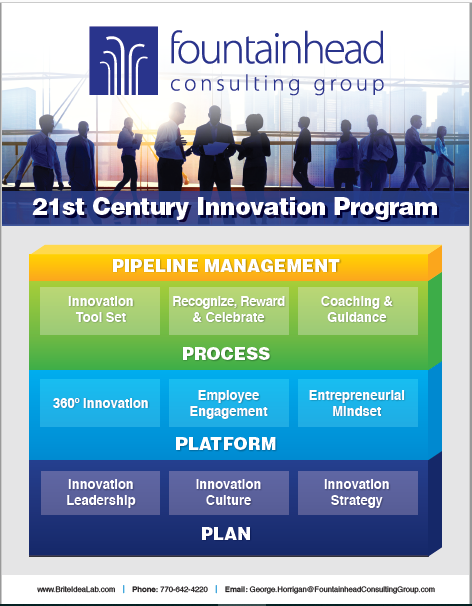Innovation: The Yin and Yang of the 21st Century
Innovation: The Yin and Yang of the 21st Century https://csuiteold.c-suitenetwork.com/advisors/wp-content/themes/csadvisore/images/empty/thumbnail.jpg 150 150 George Horrigan https://secure.gravatar.com/avatar/3fe346f330edce3ef4983e11e9279e1e?s=96&d=mm&r=gInnovation: The Yin and Yang of the 21st Century
Over the past 20 years, there has been an increasing interest in the topic of innovation, and virtually every business, organization, and country espouses the virtues of innovation.
This is reflected in a recent survey published in The Business Journals which showed that the second biggest challenge facing companies was Increasing Profit. It reported 45% of business owners surveyed were looking to improve customer experience, launch new products, and expand into new markets. Innovation is the key to accomplishing these objectives.
However, desiring innovation is like wanting good government—everyone yearns for it, but how does one actually put in place a government that properly serves its citizens?
As many of you know, I am a noted Innovation Expert and I regularly write and speak on the topic of Innovation. Because of a growing desire by companies to explore how to become more innovative, for the next 12 months each of my monthly newsletters will address a different aspect of innovation.
From an overall perspective, the problem facing business owners and leaders across the world is how to utilize innovation to develop a strategic competitive advantage?
While the benefits of innovation are manifold and alluring, this benefit stream is riddled with many questions, like:
- What is innovation?
- Why innovate?
- How do you initiate innovation?
- How can a company create an innovative culture?
- What are the steps to developing an overall innovation strategy?
- How do you sustain your innovation efforts?
- How can a business avoid being disrupted by outside innovations?
- Why do some organizations’ innovation initiatives fail?
- How can a company get its employees truly engaged in innovation?
- Are there tools you can use to facilitate and speed innovation?
- How does an organization properly encourage and reward innovation?
During the next year, I will address the above topics and many more.
We Have Moved from The Information Age to The Innovation Age
Hardly a day goes by without a major innovation or invention being introduced. However, these innovations or inventions don’t just happen. The truth is that innovation is incredibly complex, and it encompasses a number of aspects and components. If innovation was easy, the news would be filled with success stories like Google, Apple, and Amazon.
There is a specific process that enables an organization to effectively innovate on an ongoing basis. These upcoming newsletters will address the 10 steps that can be taken to transform an organization by applying 21st-century innovation to it.
To stay competitive today, the objective for any organization must be to create an innovation environment in which ideas germinate, grow to maturity and then yield a bountiful harvest.
Various thought leaders say we have moved from the Information Age to the Innovation Age, and companies that innovate faster than their competition will be the future winners. We see that all around us. New innovative companies are springing up almost overnight while other, more established organizations are struggling to survive.
Innovation and Market Disruption
A downside of emerging innovation is disruption, which has become a major force in the business marketplace. According to innovation expert, Clayton Christensen, disruption is caused by an innovation that totally changes an existing market, creates a new one or causes an existing business model or company to suddenly be undermined or become obsolete. This results in displacing market-leading firms or totally unbalancing established markets, products, or alliances. Listed below are some examples of disruption:
- Online retailer Amazon has created massive problems for retailers who have physical stores.
- Uber has disrupted the taxi, limousine, and shuttle-bus marketplace.
- Google’s new autonomous car technology is changing the entire automotive market.
“Disruption Won’t Affect Me”
You may be thinking, “Disruption won’t affect me. It only affects big companies, so it won’t significantly disrupt my small company or organization.” But that is not correct. Disruption not only affects large industries; it impacts smaller and mid-sized companies as well. For instance, one of our clients, several million-dollar-a-year family-owned companies that pioneered the Bermuda sod industry in Georgia, is being disrupted by new, innovative organizations.
These companies are buying up small sod operations, consolidating them, and deriving cost savings and efficiencies from combining them. They are then cutting the price on sod and using social media and other mass advertising to increase their sales volume. This is proving to be a huge challenge for our client.
It might be helpful to take a minute and consider your marketplace, then write down disruptions that are currently affecting your company. You also may want to do some research on emerging innovations that could affect your future operations.
There are only two possible responses that an organization can opt for in the face of this looming challenge of disruption. First, ignore the disruptive forces, and hope they simply go away. Second, acknowledge the disruptive influences, stay abreast of their ongoing development, and embrace the use of innovation as a counter-offensive to guard against disruption battering their company.
Next month I will discuss the topics of:
What is innovation?
The nine different types of innovation.
If you would like to discuss and explore how your company can become more innovative, please contact us using the below information so we can show you how to embrace a 21st-century approach to innovation.
Fountainhead Consulting Group, Inc. is an Innovation and Business Planning firm. During the past 17 years, we have shown over 1,200 companies how to achieve their goals by using our unique, comprehensive, and systematic FastTrak Innovation Program™, Innovation Academy™, and Structure of Success™ methodologies. Using the components in these methodologies, each month we examine an aspect of how to transform your business or organization into a true 21st Century enterprise.
Office phone: (770) 642-4220
www.FountainheadConsultingGroup.com
George.Horrigan@FountainheadConsultingGroup.com


